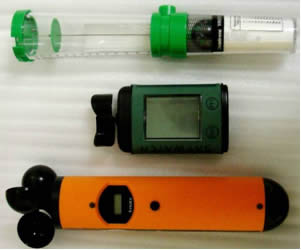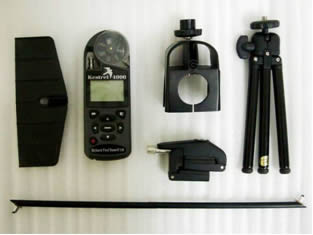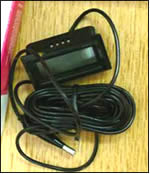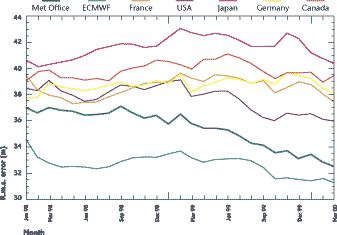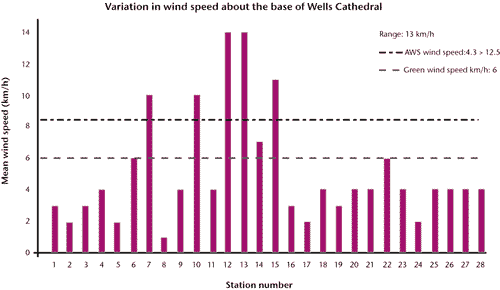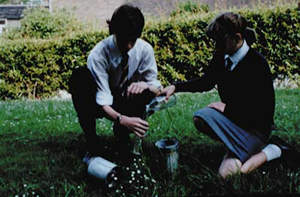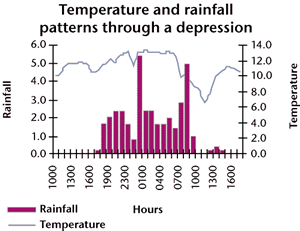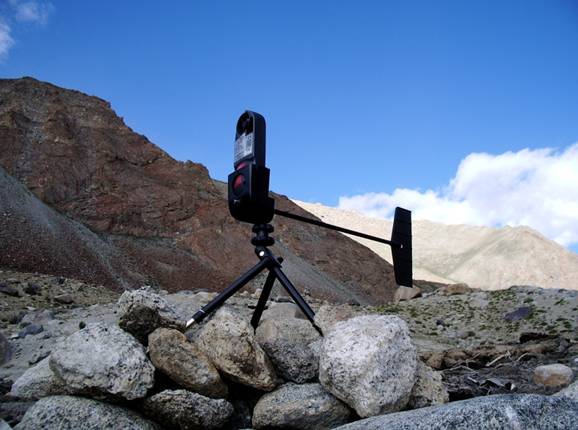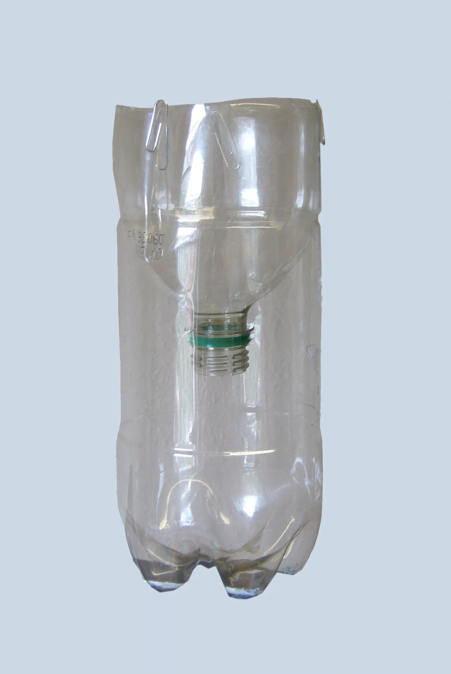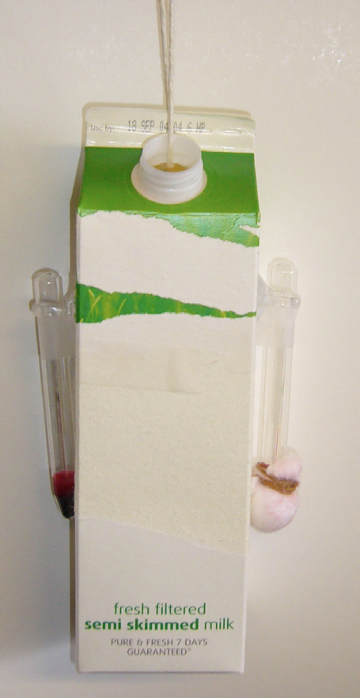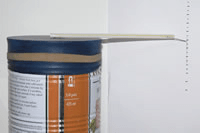Why you need one; what to buy; where to put it; what to do with the data.
Geoff Jenkins 2014
Why does our school need a weather station?
There are lots of reasons why a weather station will be welcomed as a valuable new resource to the school. Some of those given below are more suited to primary schools, others to secondary ones.
- The National Curriculum requires weather to be measured. Weather and climate feature several times in the new (2014) English National Curriculum for geography. In science, the Year 1 PoS requires that “pupils should be taught to observe changes across the four seasons, and observe and describe weather associated with the seasons”. Guidance suggests that “Pupils should observe and talk about changes in the weather, and work scientifically by making tables and charts about the weather.” And in Years 3 and 4 they should “make systematic observations using … thermometers and data loggers”.
- Weather also links naturally into many other subjects such as History (weather affecting the outcome of battles, eg D-day), ICT (make your own instruments, weather blog/website, linking to the internet), Maths (analysing and plotting real-world data), English (write stories about unusual weather – maybe even get the local paper interested in printing a routine report), Art (Turner, Constable, etc) and even Sport (performance in different conditions).
- Having a display of current weather, perhaps in the school’s main foyer, is a great general resource and talking point, especially at times of unusual weather – hot days, cold mornings, torrential rain and so on. In primary schools this can get pupils used to thinking scientifically, using units (ºC, mm of rain, etc.) and decimals. They will also learn to associate measurements of weather with their personal comfort, for example outside at break time. It can also help with practical decisions, eg has there been too much rain today to allow the playing field to be used?
- Even a cheap weather station can be linked to a computer, so that readings from the weather station can be shown on the school’s website; this will impress parents and prospective parents. If the school is in a village or small town that is unlikely to have any other weather station, then this information can be useful for others in the community and help build links.
- You can add many other features to the website weather display, such as satellite photographs, weather maps and even your own webcam looking at the sky. You could add pupils’ own photographs of weather events, such as frost or snow.
- With the right (free) software, your weather readings can be sent automatically to the Met Office, where they are shown hour-by-hour on a website (called WOW) alongside thousands of others from all over the world – a great resource when teaching about UK and world climate.
- A weather station can be used as an integral part of a school Weather Club, Environment Club or Science Club.
- Extreme weather seems to make the TV news headlines very frequently. So what was the weather like at our school yesterday when there was heavy flooding in Somerset or damaging winds in Wales?
What type of weather station should we buy?
The first choice you need to make is between a traditional manual weather station and a wireless automatic station. These are described below together with some discussion of pros and cons in each case. If you have already decided you want an automatic type then skip the next section.
A traditional manual weather station
This type uses instruments to measure temperature, including maximum and minimum, and humidity, kept in a white louvred screen (“Stevenson screen”) to keep sunshine from warming up the instruments. Alongside this will be a rain gauge on the ground. The photos below show such an arrangement using glass thermometers, but mechanical (dial-type) ones can be used just as well. Wind measurements can be made with a hand-held anemometer, and pressure using a barometer on the classroom wall. More about setting up this type of weather station, and the instruments that could be used, can be found at:
Simple Weather Instruments.pdf
http://www.weatherforschools.me.uk/html/clouds.html
Typically, a couple of pupils will be assigned to go outside in the morning and at lunch time, and jot down readings, and display them in the classroom or foyer. If you want to keep long term records then they can be entered into a log book or (more commonly these days) a spreadsheet. One big advantage of using manual instruments is that they have to be read, which gives lots of practice with scales and units

(Left) A traditional manual weather station, with thermometers for measuring humidity (left) and maximum and minimum temperature (right), in a small louvered screen. (Right) A simple plastic rain gauge with, alongside, a cylinder to measure the rainfall collected.
How much does it all cost? The collection of instruments illustrated above can be bought separately for a total of about £100 (including a self-assembly screen). Anemometers will be around £60, and a barometer about £20. Although the Royal Meteorological Society does not recommend specific instruments, suppliers such as MetCheck and Brannan carry a wide range and can be found easily online.
What about using instruments we make ourselves? There are plenty of examples shown at: https://www.metlink.org/experiments/ and while these are great for teaching principles, they are generally not accurate or robust enough to be used outside for long periods.
A wireless automatic weather station
Wireless automatic weather stations (AWS) send all the information you need right into your classroom. They have two separate parts, outdoor and indoor, as illustrated below. A number of sensors are mounted outside on a mast attached to a building, with electronics that transmits data to a receiver console inside the school. Most AWS will measure temperature, humidity, rainfall, wind speed and wind direction. The indoor console will display these measurements (plus pressure), and in many cases also store them for a few weeks; they can then be downloaded into a PC using a USB cable. The weather station can be taken out of the box and set up by someone without a detailed technical knowledge of either weather or computing, using the instruction book provided.

A typical wireless automatic weather station costing around £60, with the sensor array outdoors (left) and the console which displays and records the data (right). But don’t put too much faith in the forecast shown.
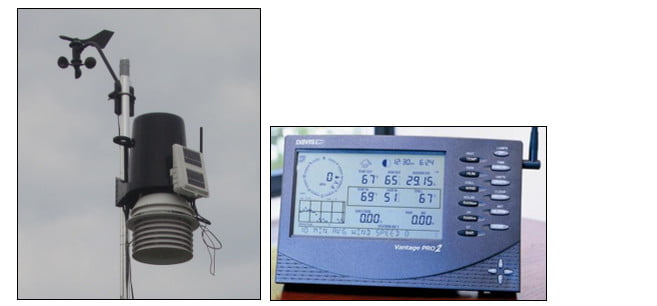
A wireless automatic weather station and indoor console at the other end of the price range, costing around £900.
The price of such a weather station can be anywhere from £60 up to £900. In general, you get what you pay for, and pricier stations will generally be more accurate and reliable, and measure more things (solar radiation, for example). In many cases, the main problem with budget weather stations is that the temperature and humidity sensors aren’t very well screened from sunshine, so they can often read a few degrees too high. But even if you cannot afford to spend a few hundred pounds, quite a lot can be got from stations at the lower end of the market, so lack of massive funds should not stop you buying something.
Although the Royal Meteorological Society does not recommend specific instruments, suppliers such as Maplin, Oregon, ProData and Weathershop carry a wide range of products and can be found easily online.
Where should we put it?
The good news is: you are not trying to be an official Met Office station! Many schools and enthusiasts are deterred from setting up a weather station because they think that observations can only be made if you have a large expanse of open area away from buildings. This just isn’t true – perfectly good readings can be taken in pretty much any situation – many schools and amateurs attach their stations to the top of a building wall. It all comes down to what the readings represent – most Met Office stations are needed to represent weather that occurs in open, unsheltered, conditions, so there are strict rules about proximity to buildings and trees. In addition, measurements of different weather elements have to be at set heights above the ground: temperature and humidity at 1.2m, rainfall at 0.3m and wind speed and direction at 10m. But your weather station doesn’t have to do all this, it just has to represent what the weather is like around your school – which may be similar to that around many other schools and back gardens, but will probably be nothing like that at a Met Office station. So do not let a lack of perfect exposure to weather put you off setting up a station.
Having said that, if you are lucky enough to have an area at ground level which is as open to the weather, and can provide a pole for the anemometer and some fencing to protect the station, then your data will look more like that at official stations.
As noted above, one common method for mounting a wireless automatic weather station is on the side of a wall, poking above a roof, perhaps on an outbuilding (see photos below). If possible, put the anemometer and wind vane up higher than the other instruments so that the speed and direction of the wind is less affected by buildings. You could even attach it to an existing lamppost or tall fence.
The transmitter part of the weather station has to be reasonably close to the receiver console, somewhere between 50m and 300m depending on the type, or even closer if the radio signal has to penetrate walls. Always check that you have good reception before you finally decide on a spot.
Vandalism can be a problem, so mount it out of reach, or use fencing (which can be expensive). On the other hand, someone in charge will need to access it from time to time (see next section), so think about the safety issues too.
Two videos (Location Part 1 and Location Part 2) from the London Grid for Learning (LGfL) discuss some of the issues:
http://weatherstations.lgfl.org.uk/maintenance.html
You can also Google “school weather station” images, to see examples of what other schools have decided to do – these show both automatic weather stations and traditional manual ones.
The final decision is always going to be a trade-off between several factors: as open to the weather as possible, accessibility for maintenance, security from damage and distance from the receiver. Quite often, you can get a position which isn’t too bad for temperature and humidity, is just about OK for rainfall, but isn’t very good at all for wind speed and direction. Remember, do the best you can, but a less-than-perfect exposure is better than nothing. But bear in mind the deficiencies of location when comparing with other schools etc.

(Left) A well exposed station at Sutton, part of the LGfL network, although quite difficult to access. (Centre)The weather station at Maiden Erlegh school. (Right)A typical home weather station on the side of a garage.
What maintenance is needed?
Like most things, a weather station will perform better if it is looked after, but this doesn’t need to be very onerous.
Batteries. Even if the weather station has solar panels, batteries are needed to help the station run at night and during the depths of winter, so need changing periodically. The indoor receiver and console will also need batteries replacing, unless it has a mains adaptor.
Make a visual check from time to time to make sure the mounting pole is still vertical and hasn’t been bent over by high winds – this could affect wind and rainfall observations.
Rain gauges are prone to a couple of common problems that can be easily cured. Firstly, remove any leaves that may have gathered in the collecting funnel as eventually these can block any rain from getting to the measuring mechanism below. Secondly, lift off the funnel and check that there aren’t any spiders’ webs stopping the bucket from tipping – this is more common than you might think.
Keep an eye on your data, and in particular compare it with the nearest station (this is easy to do using the WOW network – see below). There are sometimes tell-tale signs of problems, for example lack of rainfall over a few days compared to a neighbour indicating a blocked gauge, or straight line traces invariably indicating a battery problem. Usually the pressure sensor is inside the receiver console, so if this is still working and the other readings aren’t, this may indicate a problem with the wireless link.
How do we store or disseminate the data?
Of course you don’t have to store any data, you can simply read the console (or the instruments) when you want to and leave it at that, or just note down the weather conditions, for example every morning.
The consoles of many automatic weather stations (even cheap ones) can be plugged into a PC with a USB lead and readings can be displayed on the screen using a programme supplied with the station. The console also usually acts as a logger, to store weather data, typically at 10 min intervals. The same programme also allows you to download the data (maybe every two or three weeks) and keep it as an Excel spreadsheet on the PC. This means you can plot the data on a graph later, or use it for investigations (see later paragraph). An alternative to the manufacturer supplied software is a programme called Cumulus, which is available as donation-ware from www.sandaysoft.com
Cumulus also makes it very straightforward to put your observations on the web, using the Weather Observations Website (WOW) developed by the Met Office and the Royal Meteorological Society. This network shows observations from all over the world and has the following advantages for schools:
- Forecasters at the Met Office HQ at Exeter use WOW maps to help them see if their forecast is evolving accurately, so contributing your school’s data will be helping to improve the forecast.
- If you zoom in on your own area on the map, you can see how your school’s weather compares with other nearby stations. You can also select the nearest Met Office station to compare with – but remember, that will generally have a perfect open exposure so any differences will be partly due to this.
- By clicking on your station, you can show graphs of weather over the past day or month or even longer – and, again, compare your station with a nearby one .
- You can see your data as a table, and cut and paste it into an Excel spreadsheet. As this is always available from WOW, you may decide you don’t need to download and save your data yourself.
- You can look back at maps of observations hour by hour, even months or years ago. So you can look at a special weather event such as thick fog, a baking hot day or some heavy rainfall. Or perhaps a special event such as Sports Day or a town carnival.
- If you zoom out, you can see how your weather compares with that being collected at the same time by schools in Australia or Alaska – an instant geography lesson!
- If there is an exciting weather event in some other country, such as a hurricane in Florida or a heatwave in Australia, you might be able to find evidence of it on WOW
Your WOW page allows you to add photographs of your station; this is particularly useful in showing to others how well your station is exposed. Details of how to link your weather station to WOW.
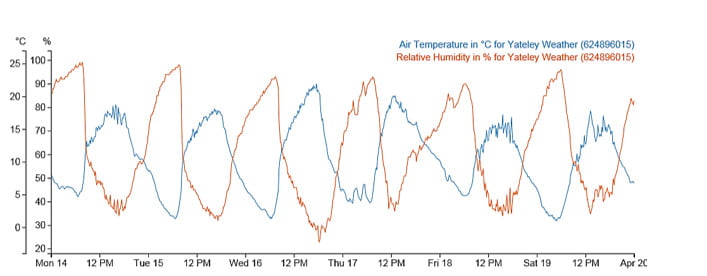
WOW can display your weather station data over any time period in the past, in this case a week with warm and dry days and cool and humid nights.

(Left) Using WOW it is easy to compare your readings with other schools or amateurs in the same area. This shows relative humidity in the Reading – Farnham area reported by 17 stations. (Right) Temperatures across the UK at the time of the 2014 London Marathon; cool areas are green, warm areas are orange.

Using WOW for an instant view of world weather (January 2014); on this day the temperature ranged from -20ºC in Alaska to +38ºC in Australia.
How can we use the weather station for teaching activities?
- Plot on a graph (using a spreadsheet or manually) pairs of weather elements, to see if there is any correlation between them. These could include rainfall and temperature, rainfall and pressure, temperature and wind speed, or wind speed and time of day. If there does appear to be a correlation, why should this be?
- How does weather vary each season? Each month? What has the weather been like over the past week?
- Produce a weather report for the day and present it as if you were a TV weather presenter.
- Compare your readings with those from a nearby school or schools (you could use WOW for this) and explain the differences. You could forge links with the other school(s) to make this a joint project.
- Host visits from other local schools that don’t have a weather station, to tell them what they are missing and help them set up their own.
- Invite the Maths department to make full use of your data to teach statistics and graphs or as the basis of projects. This could include the correlations idea, above. Once you have a few years’ data, you can ask questions such as “What is the probability of getting frost at our school”, “How likely am I to get wet if I am playing football outside for an hour” or “Does it rain more at weekends than during the week?”
- Once the school has collected, say, 5 years of data, this can be used to look at average conditions, and published (eg on the website) as “The climate of Meldrew School”.
- Keep a log (either online or on the PC or even in a book) of “Weather extremes for Meldrew School”. Add the date and time of new extremes of temperature, wind speed etc. New extremes get more exciting as time goes on.
- Add in visual observations of clouds (amount and type) and visibility, thunder and lightning, snow, sleet, hail, etc.
- Use your school weather station to lead into the topic of climate change by pointing out that it is an affordable version of the sort of weather stations which are deployed in their tens of thousands all over the world. A careful examination of the data from those that have been operating for several decades allows us to say if climate is changing.
- The weather station is a natural way to introduce many concepts in science – water vapour as a gas, evaporation and condensation, atmospheric pressure, solar radiation, etc
- Link it to simple experiments such as making a cloud in a plastic bottle or making a tornado, which can be found at: https://www.metlink.org/experiments/ or demonstration videos at http://www.youtube.com/playlist?list=PL4D17D18D91FA431E&feature=plpp
- Use the weather station to test the accuracy of home-made instruments such as a barometer, hygrometer, anemometer or rain gauge given at https://www.metlink.org/experimentsdemonstrations/
- Compare the weather station data with measurements in different parts of the school using handheld instruments such as anemometers, simple rain gauges and thermometers, to build up a picture of the school’s microclimate
- Use the microclimate data collected in the project above to make practical decisions about where would be the best place to put a wind generator, a rainwater collector or a solar panel.
(See in addition some of the points made in the opening page of this note).
Further information
Try Googling “running a school weather station” to see what others have done, and what they get out of it.
There is a wealth of forums on the web, run by both education and weather enthusiasts, where answers to many questions can be found.
Some of the ideas in this paper have come from online articles by Martin Sutton, who runs a weather station at Maiden Erlegh School near Reading. You can read more of his excellent advice at: http://www.weatherstations.co.uk/maiden-erlegh.htm
If you want to read a bit deeper, but still in an understandable way, about weather stations, get hold of a copy of the Weather Observers Handbook by Stephen Burt. http://www.cambridge.org/gb/academic/subjects/earth-and-environmental-science/atmospheric-science-and-meteorology/weather-observers-handbook?format=PB

